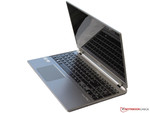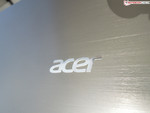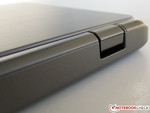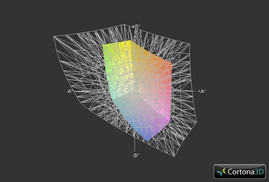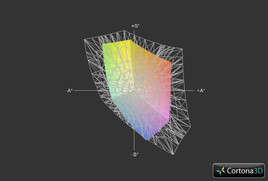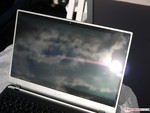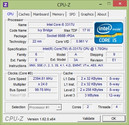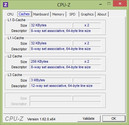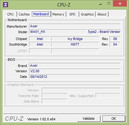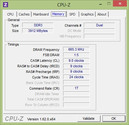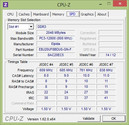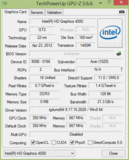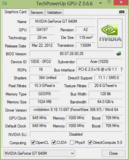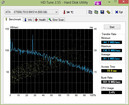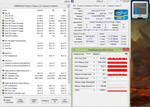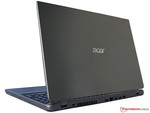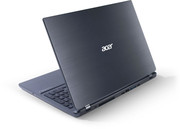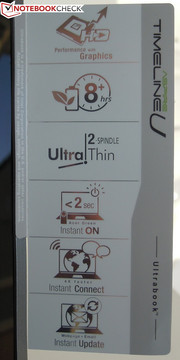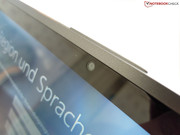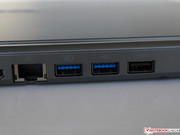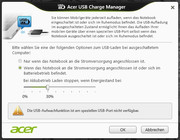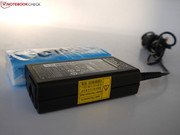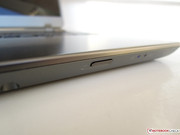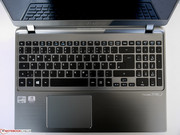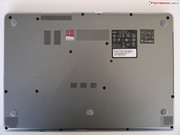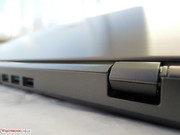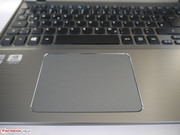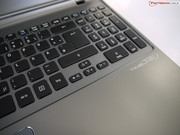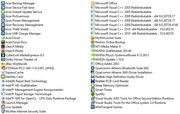Review Acer Aspire Timeline Ultra M5-581TG Ultrabook

For the original German review, see here.
Most Ultrabooks feature 13.3-inch displays - although there are larger variants on the market. Our review model - the Acer Aspire Timeline Ultra M5-581TG - is one of those rare large-screen Ultrabooks: 15.6 inches actually make it one of the largest of its kind. In addition to the display size, Acer sets the exotic system apart by including a dedicated and rather powerful Nvidia GPU. Competing systems are therefore few and far between: examples are the HP Envy 6-1000sg and the Asus S56CM, which features less powerful graphic options than the GeForce GT 640M used in the M5. Acer also uses the same powerful GPU in the Aspire Timeline Ultra M3-581TG. The difference between the two Ultrabooks is the position of the ports, choice of materials and hence the price. How the Timeline Ultra M5 fares against the competition (and if we can wholeheartedly recommend the system) is the subject of this review.
Case
The chassis of the Acer Aspire Timeline Ultra M5 is mostly made of an aluminum and magnesium alloy; the bottom of the base unit features color-matched plastic instead. Acer's Timeline Ultra M3 Series uses plastic throughout - only the display lid is constructed using the aforementioned alloy. Because of the materials, the (more expensive) M5 models look a bit more upscale. Another difference between the two series is the dimensions: the Aspire M5 measures 366 millimeters (14.41 inches) and is about 10 millimeters (0.39 inches) less wide than the M3. The difference in depth is very close - 256 millimeters (10.08 inches) for the M5 and 253 millimeter (9.96 inches) for the M3. The height of both units is barely under Intel's maximum specified thickness of 21 millimeters (0.826 inches) for 15.6-inch Ultrabooks - we measured 20.6 for the M5 (0.811 inches) and 20.7 (0.815 inches) for the M3.
Both Ultrabooks post similar scores for the stiffness of the chassis and general build quality. The Timeline Ultra M5 not only features upscale looks due to the aluminum surfaces - it's also quite rigid and resilient against pressure despite the slim design. The display itself is only 5.5 millimeters (0.22 inches) thick and torsionally not as rigid as the base unit - although this really doesn't detract from the overall quality. The display lid is attached to the base unit using two plastic-clad hinges, which are able to hold the display securely in any position without any wobbles. Despite the stiffness, the display lid can be opened with one hand.
Connectivity
Because of the thin design, the Ultrabook only has the most basic connections - even VGA (which is still pretty common) is missing. Most of the ports are on the back, which is not ideal - at least not as far as the three USB ports are concerned: the user needs to turn the Ultrabook around when plugging in a device. We also don't understand Acer's decision to place the power connector on the left side - we think this location would have been better suited for a USB port. We do like the HDMI connector on the back, however.
Communication
The communication options are not as restricted as the port selection. The Atheros AR5BWB222 Wireless Network Adapter allows connectivity using the 802.11 b/g/n standards. For wired connections up to 100 Mbit/s, Acer uses a Broadcom BCM57780 NetLink Gigabit Ethernet controller. Bluetooth 4.0, which supports faster device connections and requires less power, is also available.
Accessories
Aside from the Ultrabook, its power adapter, and a quickstart guide, the box also includes an M-Disc. This 4.7 GB optical media supposedly ensures that data remains readable for up to 1000 years. The disk can only be written to in a special M-Disc capable burner; any DVD player is able to read the disk as it is backwards compatible. The M-Disc could be used to create recovery media, as Acer doesn't include such a disk and urges the user to create one.
Maintenance
The Ultrabook does not feature any maintenance covers - access to the components requires removing the screws on the bottom and taking off the top part of the base unit (including keyboard and touchpad). The procedure is not recommended and the user manual does not explain the process. Those who are sufficiently handy can gain access to the hard drive, RAM, the mSATA connection, battery, and the cooling system.
Warranty
In Germany, Acer's warranty covers the notebook for two years, while the battery and accessories are covered for one year. The user is required to bring the defective unit to an authorized repair shop (carry-in service). An extension of the warranty to 3 or 4 years is available for 79 Euros and 179 Euros (~$105 and ~$235), respectively.
Input Devices
Keyboard
The individual keys measure 14.6 x 14.6 millimeters (0.57 x 0.57 inches); the numeric keypad on the other hand consists of keys which are only 12.1 x 14.6 millimeters (0.48 x 0.57 inches) in size. The distance between the keys is very generous at 4 millimeters (0.16 inches). Although the keys feature a surface made from smooth plastic, the quality is quite decent and the overall feedback of the keyboard with its medium key travel is very good. Keyboard noise is well controlled even during fast typing sessions. The combo keys (Enter and hash, for example) require some time to get used to. The space bar doesn't register key depressions well and only works reliably when hit in the center. The keyboard is backlit, although the brightness can't be adjusted.
Touchpad
Our review model features an Elan SmartPad. The large touchpad, which measures 106 x 78 millimeters (4.17 x 3.07 inches), is slightly recessed into the palm rest and surrounded by a chrome frame. The mouse buttons are not separate but integrated into the surface itself, which can lead to errors if the user inadvertently presses the wrong one. The touchpad registers mouse clicks on the bottom third of the surface area. While the click-point is clearly defined, the required pressure is high and the clicks are quite loud. Multitouch gestures are supported and work well - the Elan SmartPad actually allows for more options than the Synaptics ClickPad used in some models. The error-proneness (compared to our test of the Aspire Timeline Ultra M3-581TG) has been reduced since the last driver update - but this button-less touchpad is still not the best solution.
Display
Acer uses an inexpensive TN display for this model. The glossy-type panel (LP156WH6-TJA2) features a resolution of 1366x768 pixels - similar to the few other available 15.6-inch Ultrabooks. The maximum brightness is low at only 190 cd/m²; the dimmest area is the bottom right corner (167 cd/m²). The average brightness is 176 cd/m² and the brightness distribution quite acceptable at 88 percent.
| |||||||||||||||||||||||||
Brightness Distribution: 88 %
Center on Battery: 184 cd/m²
Contrast: 298:1 (Black: 0.617 cd/m²)
39.7% AdobeRGB 1998 (Argyll 3D)
57.5% sRGB (Argyll 3D)
38.41% Display P3 (Argyll 3D)
The X-Rite i1Pro 2 spectrophotometer pegs the contrast at 300:1; the corresponding black point is 0.6 cd/m² in the middle of the display. Although both values are better than what most standard displays are capable of (we usually see contrast ratios of less than 200:1), the difference is not visible during daily use. Only a display like the one Asus uses for its S56CM (626:1) looks quite a bit more vivid.
As far as the professional color spaces are concerned, the M5 fails to cover sRGB and is miles away from reproducing AdobeRGB. Since this only really matters for photo editing and other professional tasks, this should not be a huge issue for the average user.
The Timeline Ultra M5-581TG is only suitable for outdoor use if it's overcast or if the notebook is used in the shade. The causes are the low minimum brightness and the reflective display panel. Even when used indoors, the panel glare makes it harder to decipher the contents of the screen.
Although the picture only changes minimally when the user deviates from the ideal 90 degrees in the horizontal plane, even small changes in the angle in the vertical plane cause color inversions (view from below) and a washed out picture lacking in contrast.
Performance
Our review model comes equipped with an Intel Core i5-3317U CPU, an Nvidia GeForce GT 640M GPU with 1 GB GDDR5 VRAM, 4 GB DDR3 RAM, and a 500 GB hard drive - enough for office work, web surfing, HD video editing, and even gaming. Those wanting snappier performance can also choose a model with 128 or 256 GB SSD. The top-of-the-line version comes with the Intel Core i7-3517U processor.
Processor
The Intel dual-core Core i5-3317U is manufactured using the 22 nm process and is a member of the third generation of "Core i" CPUs. The maximum thermal design power (TDP) of this particular processor is 17 Watts and promises long battery life. Thanks to Intel's Turbo Boost 2.0, the clock speed varies between the maximum of 2.6 and 2.4 GHz (single-core vs. dual-core) and the core frequency of 1.7 GHz. Turbo Boost also controls the integrated HD Graphics 4000, which features clock speeds between 350 and 1050 MHz.
The CPU Multi 64-bit Performance test of the Cinebench R11.5 Benchmark results in 2.38 points - about 6 percent faster than the Sandy Bridge i7-2637M processor. The Ultrabook competition has comparable (HP Envy 6-1000sg) or slightly less performance (Asus S56CM). Even though the i5-3317U consumes less power, it compares quite well with the i5-2410M, as the 3317U is only slower by about 8 percent. The i7-3517U, on the other hand, is able to outperform the processor in our review model by 16 percent.
When repeated our tests with the laptop on battery power, we got identical results - the maximum performance is also available when away from any outlets.
System Performance
The PCMark benchmark tests reflect overall system (and also perceived) performance. Systems with Solid State Drives tend to do better and achieve the top scores. Our review model reached a noteworthy 2826 points - about 10 percent ahead of the Asus S56CM. Ultrabooks with SSDs are able to outperform our review model by about 25 percent.
| PCMark 7 Score | 2826 points | |
Help | ||
Storage Devices
The Acer M5-581TG-53314G52Mass is equipped with a 500 GB hard drive from manufacturer Seagate. The 5400 RPM drive is aided by a 20 GB Cache SSD, which is connected via the mSATA interface. After Windows 8 is configured, the user is left with 416 GB of the 444 GB available. The 20 GB Cache SSD is not usable for data storage, but contributes to fast wake-up times from standby. The average transfer rate of 81.3 MB/s is very good for such a low RPM drive. The access time of 19 milliseconds is below average.
GPU Performance
The Aspire M5-581TG features two graphic cards. The switch between the Intel HD Graphics 4000 and the Nvidia GeForce GT 640M works seamlessly (triggered by the application) and is handled by Nvidia's Optimus technology. The Nvidia GPU has access to 1 GB of GDDR5 VRAM, which operates at 1000 MHz. The clock speed of the GPU is 645 MHz (higher than the standard of 625 MHz) and can reach 709 MHz as long as the thermal limits are not exceeded.
The GeForce GT 640M scored 1750 points in the 3DMark 11 Performance GPU Test, which is what we can expect from this GPU. Acer did not throttle the performance of the graphics card, even though Ultrabooks generally suffer from a lack of space. This means that the Timeline Ultra M5 features the highest-performing GPU in an Ultrabook so far. The Acer Aspire Timeline Ultra M3-581TG features the same GPU and scored 1731 points. The smaller 14-inch model of the series comes with a lesser GeForce GT 640M LE and scores about 20 percent lower. Other Ultrabooks with powerful GPUs can't keep up with our review model: the HP Envy 6-1000sg (AMD Radeon 7670M) offers about 40 percent and the Asus S56CM (Nvidia GeForce GT 635M) 42 percent less performance.
GPU performance is not reduced while the notebook is on battery power.
| 3DMark 03 Standard | 29503 points | |
| 3DMark 05 Standard | 15287 points | |
| 3DMark 06 Standard Score | 10911 points | |
| 3DMark Vantage P Result | 7566 points | |
| 3DMark 11 Performance | 1859 points | |
Help | ||
| 3DMark 11 - 1280x720 Performance GPU (sort by value) | |
| Acer Aspire M5-581TG-53314G52Mass | |
| Acer Aspire M3-581TG | |
| Acer Aspire TimelineUltra M5-481TG-73514G25Mass | |
| Asus S56CM-XX079H | |
| HP Envy 6-1000sg | |
Gaming Performance
The 3DMark benchmark tests already hinted at the high GPU performance the M5-581TG is capable of. We were able to confirm those results when we ran our gaming benchmark tests. Nearly all one to two-year-old games can be played using the native resolution and quality set to high. Only new games like Need for Speed: Most Wanted tax the GT 640M and require the quality to be reduced if the native resolution is desired. To see which other games are playable and offer decent performance, please take a look at our page for the GeForce GT 640M.
| low | med. | high | ultra | |
|---|---|---|---|---|
| Battlefield 3 (2011) | 56.6 | 40.5 | 32.4 | 14.5 |
| The Elder Scrolls V: Skyrim (2011) | 52.3 | 41.6 | 32 | 18.4 |
| Anno 2070 (2011) | 119.9 | 52.8 | 33.5 | 16.5 |
| Fifa 13 (2012) | 223.1 | 154.1 | 145.2 | 121.1 |
| World of Tanks v8 (2012) | 40.1 | 28.8 | 24 | 14 |
| Dishonored (2012) | 75.5 | 74.8 | 72.6 | 48.7 |
| Medal of Honor: Warfighter (2012) | 66.8 | 44.1 | 35.4 | 15.8 |
| Need for Speed: Most Wanted (2012) | 55.3 | 41.7 | 24.8 | |
| Call of Duty: Black Ops 2 (2012) | 88.1 | 70.3 | 42.5 |
Emissions
Even when the notebook is not under load, the system fan never stops running. With the power-saver profile activated, we measured an average of 34 dB (A) - still acceptable. The minimum is 32 dB (A). When the GPU and CPU are idling, but the maximum performance profile is activated, the fan spins up and reaches 36.3 dB (A). The system is now quite audible and maybe not suited for quiet environments. Under load, the cooling system of the M5-581TG gets pushed further - a high-performance GPU does require decent cooling - and reaches 40.7 dB (A). During our stress test (FurMark + Prime95), the system doesn't get much louder: we measured 41.6 dB (A).
Noise level
| Idle |
| 32 / 34 / 36.3 dB(A) |
| DVD |
| 36.2 / dB(A) |
| Load |
| 40.7 / 41.6 dB(A) |
 | ||
30 dB silent 40 dB(A) audible 50 dB(A) loud |
||
min: | ||
Temperature
The purpose of the noisy cooling system is to keep the components cool and lower the surface temperatures. We measured 33 degrees Celsius (91.4 degrees Fahrenheit) on the underside of the notebook - no reason for concern even when the system is used on the lap. Web browsing and the occasional HD video also caused no issues. When the system is under maximum load (GPU and CPU at 100 percent utilization) for one hour, the underside reaches 51.6 degrees Celsius in the middle (124.9 degrees Fahrenheit) and 48.6 degrees Celsius at the heat vent (119.5 degrees Fahrenheit). The side areas of the notebook don' get particularly hot and the M5-581TG can still be used on the lap. On the top, the system heat becomes noticeable when the fingers are placed on the "K" and "L" keys. Overall, the cooling system of the M5-581TG does a better job than the one of the M3-581TG as far as heat distribution under load is concerned. Under load, the latter system gets too hot to use on the lap.
While the system is under load, we check for throttling of the CPU and GPU. After a few hours, the CPU reached a maximum temperature of 95 degrees Celsius (203 degrees Fahrenheit). The Turbo clock speed of the CPU gets reduced from 2.4 GHz at the beginning of the test to the base frequency of 1.7 GHz. The Nvidia GPU, on the other hand, is subject to throttling: a GPU temperature of 90 degrees Celsius (194 degrees Fahrenheit) resulted in a reduction from 645 MHz to 405 MHz. When we ran the 3DMark test afterwards, we noticed no reduction in performance. Those interested in gaming need not worry: only when the CPU is subjected to extreme loads can GPU throttling be observed.
(-) The maximum temperature on the upper side is 54 °C / 129 F, compared to the average of 36.9 °C / 98 F, ranging from 21.1 to 71 °C for the class Multimedia.
(-) The bottom heats up to a maximum of 51.6 °C / 125 F, compared to the average of 39.2 °C / 103 F
(+) In idle usage, the average temperature for the upper side is 30.2 °C / 86 F, compared to the device average of 31.3 °C / 88 F.
(±) The palmrests and touchpad can get very hot to the touch with a maximum of 36.5 °C / 97.7 F.
(-) The average temperature of the palmrest area of similar devices was 28.7 °C / 83.7 F (-7.8 °C / -14 F).
Speakers
The two speakers are located on the front on each side and directed towards the surface the notebook is sitting on. Dolby Home Theater improves the sound - although the software can't improve the bass response of the subwoofer-less sound system. We like the music (standard), movie, and game presets. Highs and lows are adjusted depending on the situation. The maximum volume is also quite loud and remains undistorted even at the highest setting.
Those wanting even better sound quality can hook up an external speaker system using the 3.5 millimeter audio combo port or the digital HDMI connection. We had no issues using either one of them.
Power Consumption
While in standby mode, the M5 consumes 1.9 Watts, which is quite a bit more than the competition and 15.6-inch notebooks in general (which usually require less than one Watt). Even when the Ultrabook is turned off, it still needs 1.7 Watts. The Aspire M5-581TG is also not exactly frugal during idle: 9.4 to 14 Watts is more than other Ultrabooks; even the (similarly configured) Acer Aspire TimelineU M3-581TG only needs a maximum of 7.9 Watts. Under maximum load (FurMark + Prime95), the notebook required 69.3 Watts - the 65 Watt power adapter is now not sufficient any longer and can't charge the battery. The aforementioned GPU throttling is not caused by the power adapter, but is a result of high temperatures. When we ran 3DMark 06, we saw a power consumption of 58.4 Watts, which leaves a bit of a margin.
| Off / Standby | |
| Idle | |
| Load |
|
Key:
min: | |
Battery Life
Intel requires a battery life of 8 hours for first and second generation Ultrabooks. Our review model reaches 11 hours and 12 minutes during the Battery Eater Reader’s Test (deactivated wireless and display brightness turned all the way down) - an excellent value. Without Nvidia's Optimus technology, the battery life would only be 4 hours and 22 minutes. For the other end of the spectrum, we use the Battery Eater Classic Test, which taxes both the CPU and the Nvidia GPU (using an OpenGL calculation). For this particular test, we enable all wireless modules and set the display brightness to 100 percent. Under these circumstances, it took 2 hours and 39 minutes before we had to plug the notebook back in - a very good result considering the powerful GPU. Less impressive was the result of our WLAN surf-test: with the Intel HD Graphics 4000 activated and the display set to 155 cd/m², we recorded about 5 hours - a below average result for an Ultrabook. When playing DVDs (with the display set to maximum brightness), the M5-581TG lasted 4.5 hours, which is enough for two movies. Charging the battery while the system is under a light load takes 3.5 hours.
Since the battery is integrated, it's not possible to swap it out for a higher capacity model - since the results are decent overall this is not really a point against the system. The power adapter weighs in at 353 grams (0.78 pounds) and won't always be needed.
Verdict
The Acer Aspire Timeline Ultra M5-581TG offers a gaming-capable GPU paired with decent battery life. The high quality aluminum chassis is thin and features upscale looks, the price of 799 Euros (~$1060) attractive and fair. Although the very good impression is hampered a bit by the fan control and the just average display, the system is a pretty convincing package overall. Acer's own M3-581TG lasts a bit longer per charge when surfing via WLAN and is about 150 grams (0.33 pounds) lighter. Points against this particular model: the (lower quality) materials and the high surface temperatures. Since the M3 has a street price of 619 Euros ($819), it's significantly cheaper and in our opinion the better choice. If gaming is not high on the list of priorities, the HP Envy 6-1000sg (which retails for 729 Euros / ~$965) deserves a look. This model is faster when starting programs (thanks to its 32 GB Samsung SSD), but GPU performance and build quality fall behind.
If a couple of millimeter more in thickness don't really matter, the potential buyer can also look for models that don't fulfill the Ultrabook specifications, but are still slim and light systems. The Acer Aspire V5-571G is quite inexpensive (starting at 450 Euros / ~$595) - but its battery life is more in line with regular notebooks.




